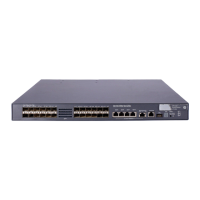5
To do… Use the command… Remarks
1. Enter system view
system-view —
2. Enter Ethernet interface view
interface interface-type interface-
number
—
3. Enable TxRx mode flow
control
flow-control
4. Enable Rx mode flow control
flow-control receive enable
Required.
Use either command.
By default, flow control is
disabled on an Ethernet interface.
Configuring PFC on an Ethernet interface
PFC performs flow control based on 802.1p priorities. With PFC enabled, an interface requires its peer to
suspend sending packets with certain 802.1p priorities when congestion occurs. By decreasing the
transmission rate, PFC helps avoid packet loss.
You can enable PFC for certain 802.1p priorities at the two ends of a link. When network congestion
occurs, the local device checks the PFC status for the 802.1p priority carried in each arriving packet.
• If PFC is enabled for the 802.1p priority, the local device accepts the packet and sends a PFC pause
frame to the peer. The peer stops sending packets carrying this 802.1p priority for an interval as
specified in the PFC pause frame. This process repeats until the congestion is removed.
• If PFC is disabled for the 802.1p priority, the local port drops the packet.
Each local precedence value corresponds to a queue. The 802.1p-to-local priority mapping is as shown
in Table 1. Modif
y the 802.1p-to-local priority mapping table with the qos map-table dot1p-lp and import
import-value-list export export-value commands. For more information about the two commands, see the
ACL and QoS Command Reference.
Table 1 The default 802.1p-to-local priority mapping table
802.1p priority Local precedence value
0 2
1 0
2 1
3 3
4 4
5 5
6 6
7 7
To configure PFC on an interface:
To do… Use the command… Remarks
1. Enter system view
system-view —
2. Enter Ethernet interface
view
interface interface-type
interface-number
The PFC feature is available only on
10-Gigabit interfaces.

